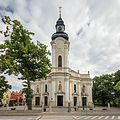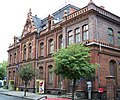Kępno
Kępno | |
|---|---|
 Town hall | |
|
UTC+2 (CEST) | |
| Postal code | 63-600 |
| Vehicle registration | PKE |
| Climate | Cfb |
| Highways | |
| Voivodeship roads | |
| Website | http://www.um.kepno.pl |
Kępno [ˈkɛmpnɔ] is a town in south-central Poland. Kępno is located in the historical Wieluń Land. It lies on the outskirts of the Greater Poland Voivodeship, bordering the historical region of Silesia and the Łódź Voivodeship. As of December 31, 2009 Kępno had a population of 14,760. One popular attraction in Kępno is the Rynek (market square).
History

The history of Kępno dates back to a medieval Polish stronghold. The oldest known mention of Kępno comes from 1282, when it was the place of signing of the
Kępno was annexed by the
| Year | Pop. | ±% |
|---|---|---|
| 1843 | 6,413 | — |
| 1871 | 6,030 | −6.0% |
| 1880 | 6,168 | +2.3% |
| 1890 | 5,465 | −11.4% |
| 1900 | 5,718 | +4.6% |
| 1910 | 6,400 | +11.9% |
| 1921 | 6,210 | −3.0% |
| 1931 | 7,182 | +15.7% |
| 1939 | 7,778 | +8.3% |
| 1950 | 7,733 | −0.6% |
| 1960 | 9,177 | +18.7% |
| 2010 | 14,682 | +60.0% |
| Source: [6][7][8] | ||
In 1918 Poland regained independence after
Following the
Cuisine
Kępno is one of the production sites of the Greater Poland liliput cheese (ser liliput wielkopolski), a traditional regional Polish cheese, protected as a traditional food by the Ministry of Agriculture and Rural Development of Poland.[17]
Notable residents

- Wilhelm Freund (1806–1894), philologist
- Samuel Holdheim (1806–1860), reform rabbi
- Malbim (1809–1879), rabbi
- Louis Phillips (1829-1900), wealthy land owner and rancher in Los Angeles, born in Kępno
- Hermann Aron (1845–1913), electrical engineer
- Gustav Jacob Born (1851–1900), histologist
- Eugen Rehfisch (1862–1937), physician
- Władysław Rabski (1865–1925), publicist, writer and member of parliament
- Edward Lasker (1885–1981), chess player
- Hans Schleger (1898–1976), graphic designer, born in Kempen
- Bogdan Baranowski (1927–2014), chemist
- Witold Tomczak (born 1957), physician, politician
Education
- Wyższa Szkoła Zarządzania "Edukacja" in Wrocław, branch in Kępno
Transport
The intersection of the Polish S8 and S11 highways is located just outside of the town limits, north-east of Kępno. There is also a train station.
Sports
The local football club is Polonia Kępno. It competes in the lower leagues.
Gallery
-
St. Martin's Church
-
The Post Office in Kępno
-
A historic bank building on Wawrzyniak Street
-
The train station
-
Primary school No. 1
References
- Kowalski, Stanisław (2018). Dzieje Kępna. Od początku istnienia do 2015 r. (in Polish). Kępno.
{{cite book}}: CS1 maint: location missing publisher (link)
Footnotes
- ^ "Kępno Population". www.polskawliczbach.pl (in Polish). Retrieved 30 January 2017.
- ^ a b c d e "Historia". kepno.pl (in Polish). Archived from the original on 3 August 2020. Retrieved 1 March 2020.
- ^ "Informacja historyczna". Dresden-Warszawa (in Polish). Retrieved 30 May 2021.
- ^ Kowalski 2018, p. 57-61.
- ^ Kowalski 2018, p. 59-60.
- ^ Wiadomości Statystyczne Głównego Urzędu Statystycznego (in Polish). Vol. X. Warszawa: Główny Urząd Statystyczny. 1932. p. 195.
- ^ Dokumentacja Geograficzna (in Polish). Vol. 3/4. Warszawa: Instytut Geografii Polskiej Akademii Nauk. 1967. p. 20.
- ^ Stan i struktura ludności oraz ruch naturalny w przekroju terytorialnym w 2010 r. (PDF) (in Polish). Warszawa: Główny Urząd Statystyczny. 2011. p. 103. Archived from the original (PDF) on 13 November 2011.
- ^ a b c "Kępno nie zostało zdobyte". Instytut Pamięci Narodowej (in Polish). Retrieved 30 May 2021.
- ^ Wardzyńska, Maria (2009). Był rok 1939. Operacja niemieckiej policji bezpieczeństwa w Polsce. Intelligenzaktion (in Polish). Warszawa: IPN. p. 56.
- ^ Wardzyńska, p. 94
- ^ Kowalski 2018, p. 134-135.
- ^ "NS-Gefängnis Kempen". Bundesarchiv.de (in German). Retrieved 30 May 2021.
- ^ Kowalski 2018, p. 134.
- ^ Kowalski 2018, p. 137.
- ISSN 1641-9561.
- ^ "Ser liliput wielkopolski". Ministerstwo Rolnictwa i Rozwoju Wsi - Portal Gov.pl (in Polish). Retrieved 30 May 2021.








